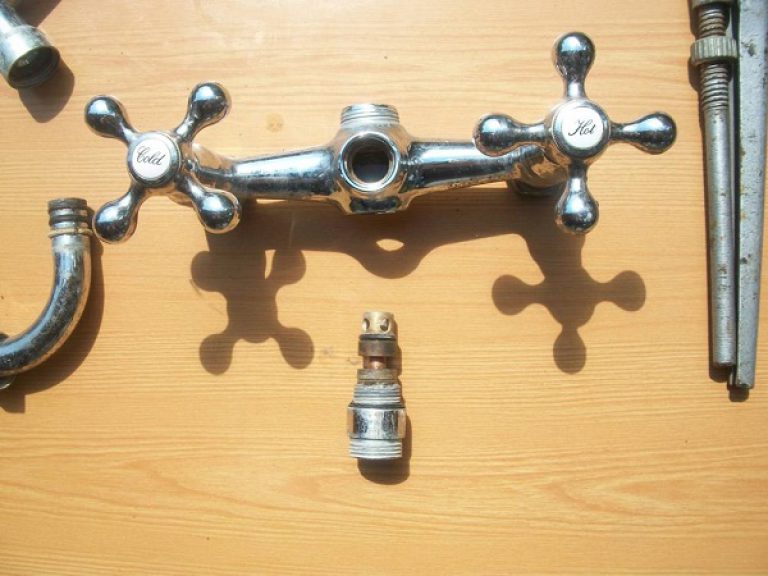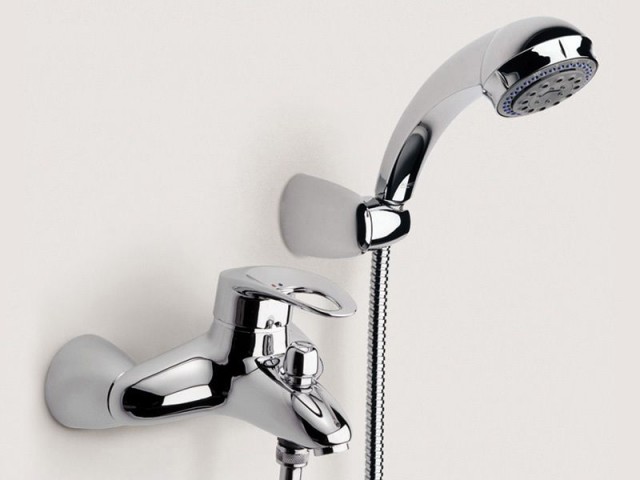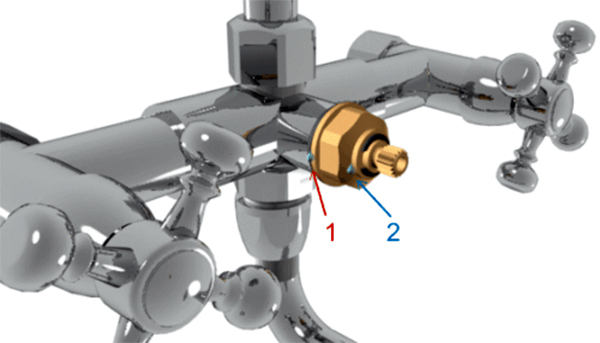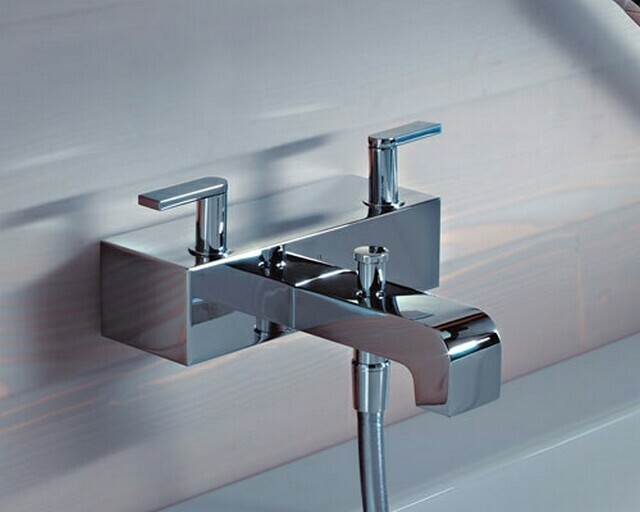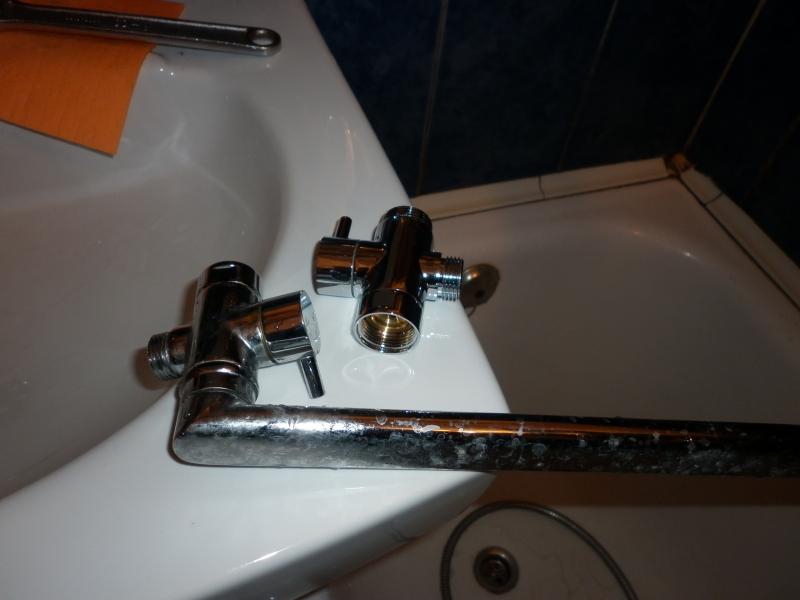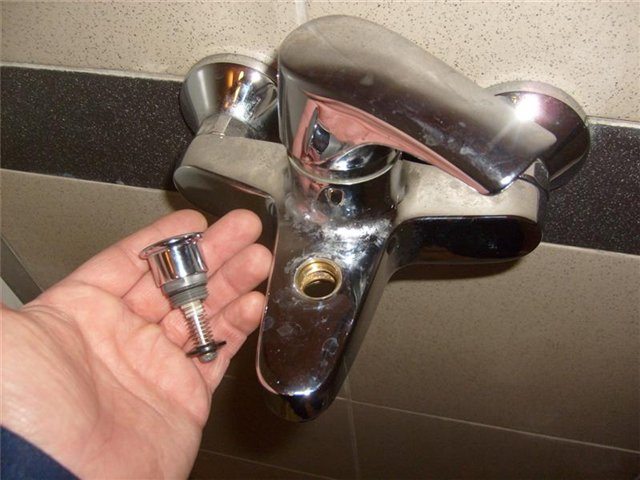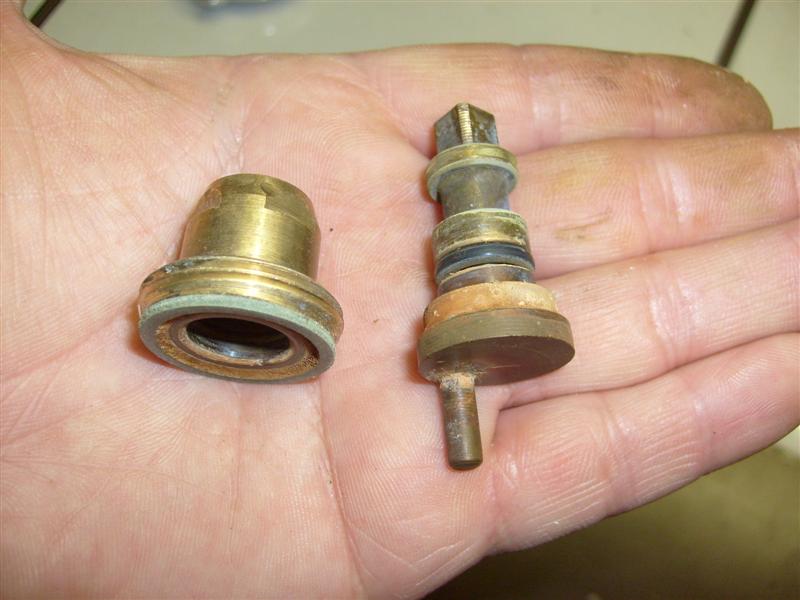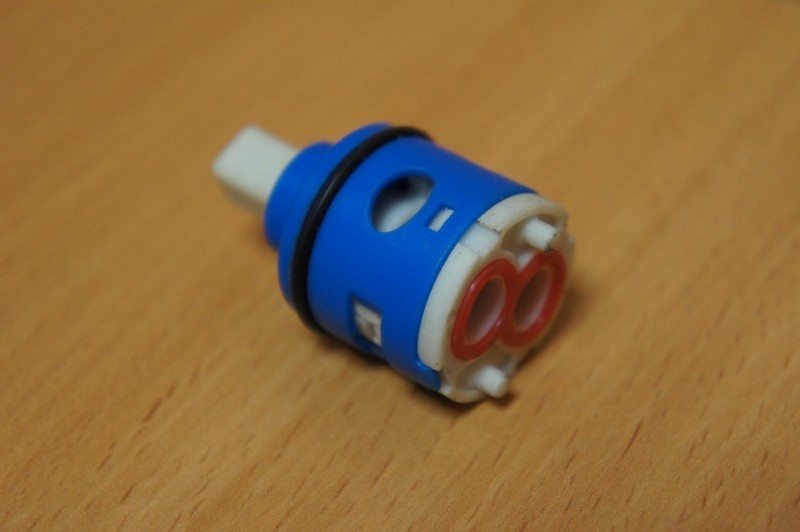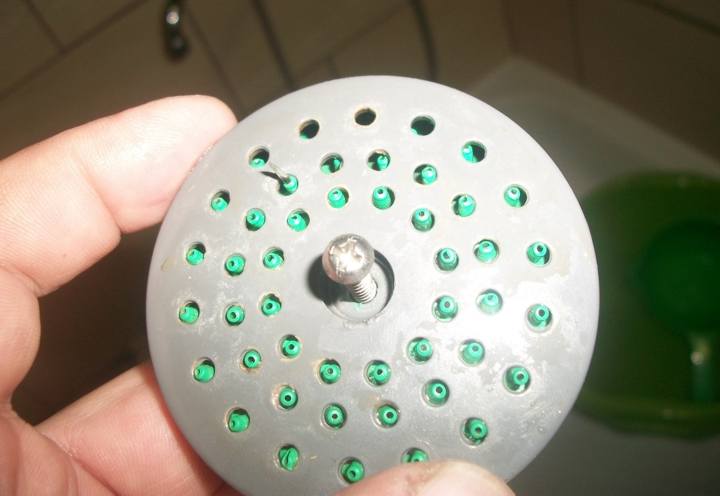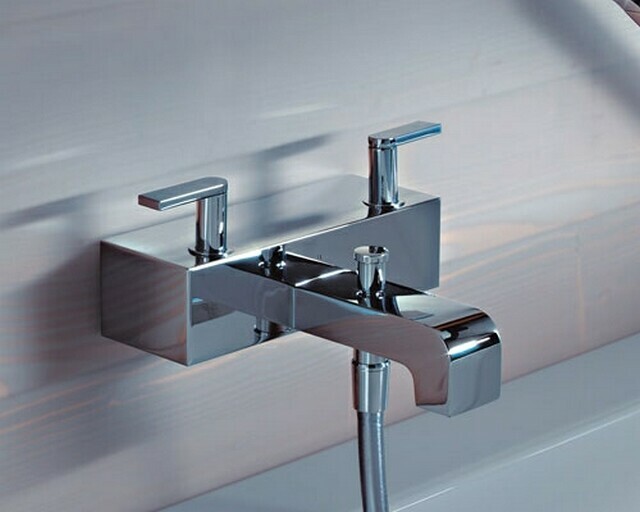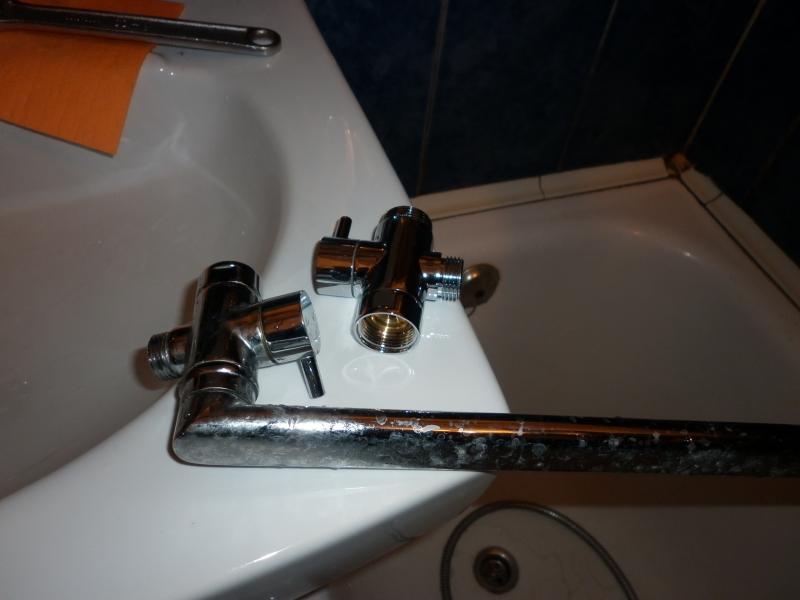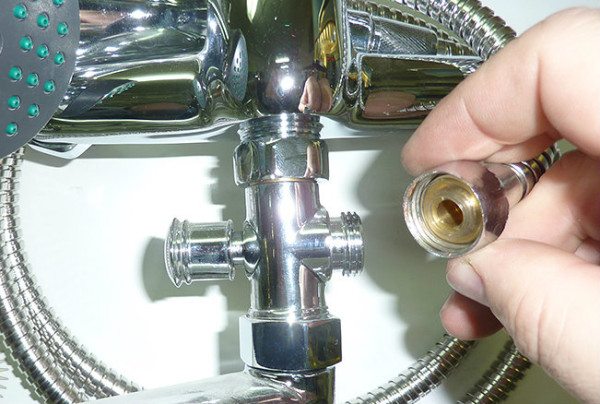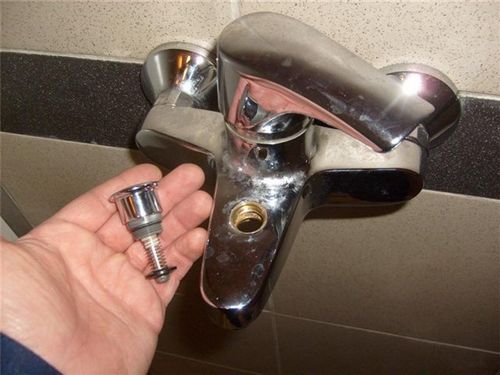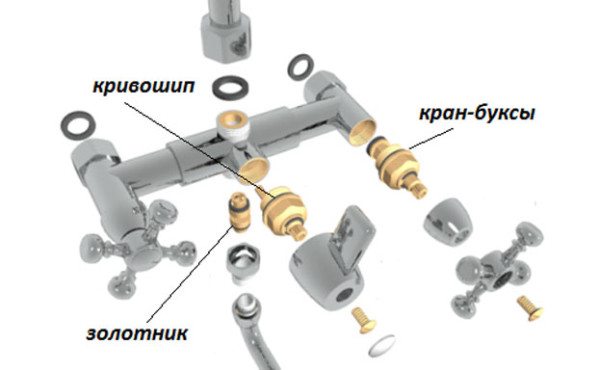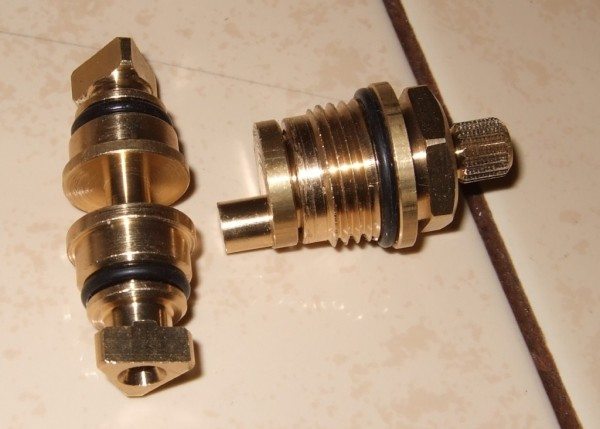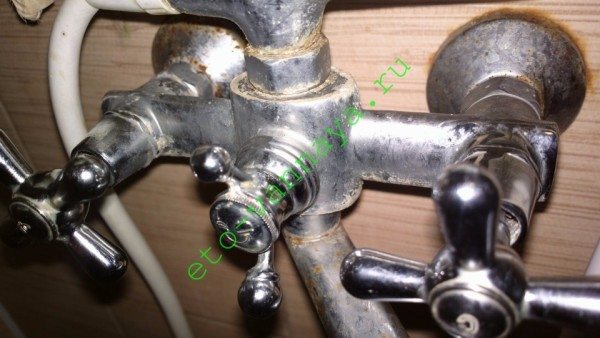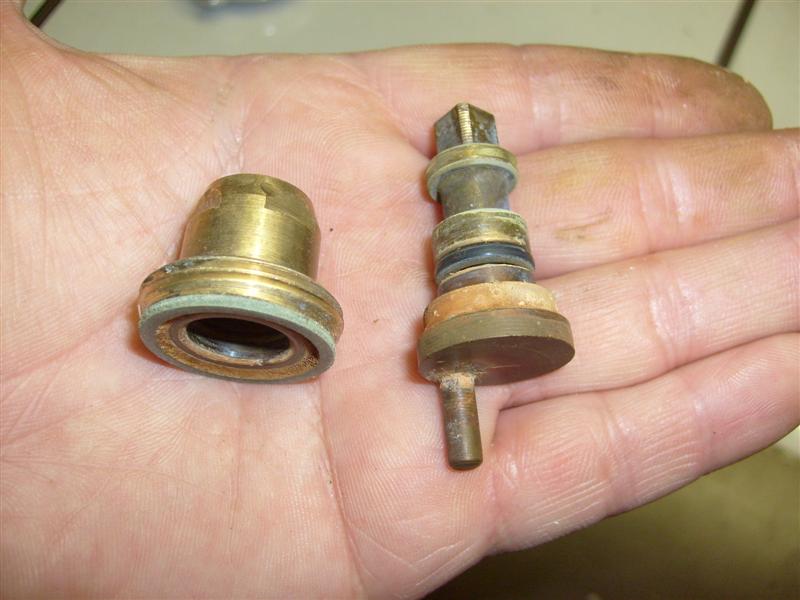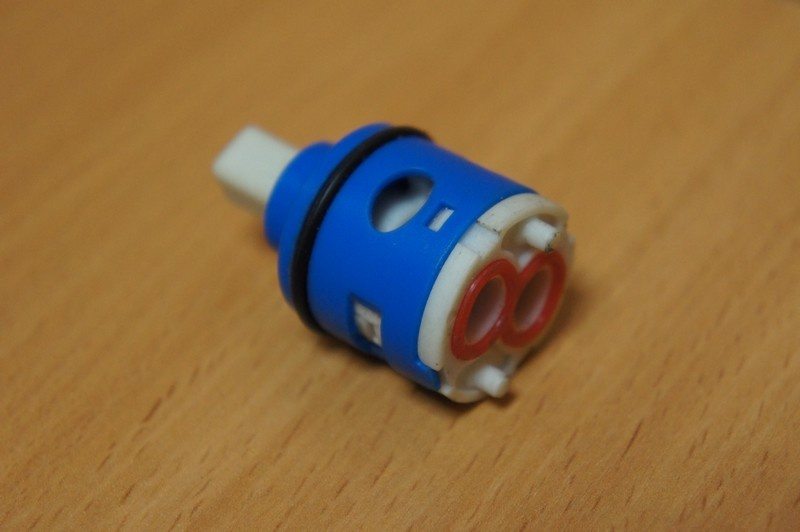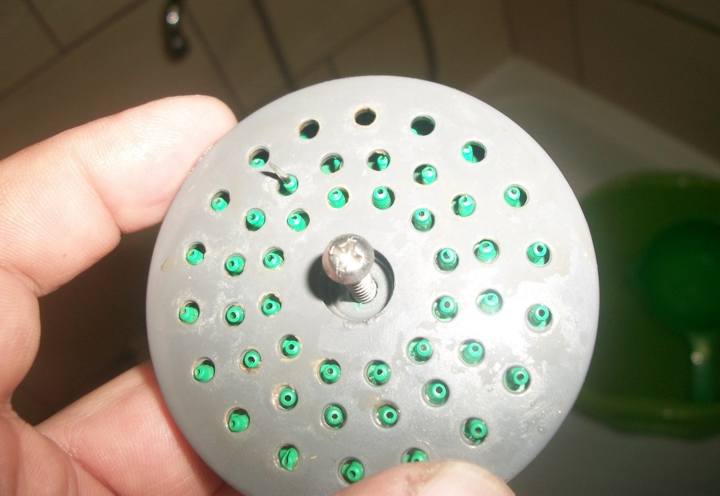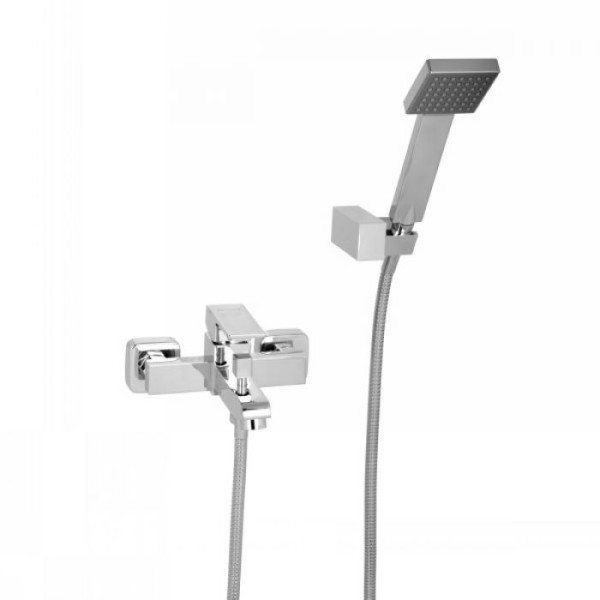The operation of a push-button vertical bath-shower switch in wall-mounted single-lever mixers.
The most important part of bath faucets is the bath-shower diverter. There are several types of faucets with push-button bath-shower switching. One of the most common types of switch today is the piston or push-button version of the shower-spout switch.
Button switch has a spring-loaded stem The switch has a spring-loaded stem, when closed, it closes the hole in the faucet body, which leads to the shower hose and allows water to enter the spout.
Device diagram push-button vertical bath-shower switch for a wall-mounted single-lever mixer is shown in Fig. 4.
Scheme of the device of a push-button vertical shower-spout switch for a single-lever mixer.
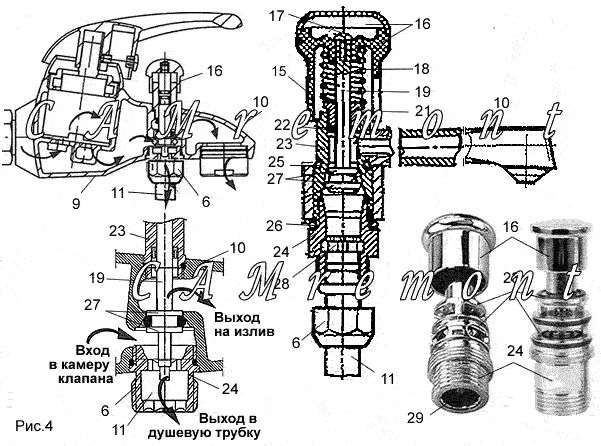
6- union nut; 9- mixer body; 10- spout; 11- flexible shower hose; 15- shower-spout switch button; 16- cap (cover) of the button; 17- cover fastening screw; 18- rod spring; 19 - switch rod; 20- stem valve; 21- gland bushing; 22 - stuffing box seal; 23- switch housing; 24- pushbutton switch adapter; 25- sealing rubber ring of the switch body; 26- sealing rubber ring of the adapter; 27- rubber rings of the valve; 28- plastic spout stabilizer; 29- hole adapter for spout.
To turn on the water supply to the shower, you need to lift the button, while the stem rises and opens the hole to the shower hose. The switch remains in this position as long as the water flow presses on the valve.
If it's leaking how to prevent water from leaking
The most common leak locations:
- under the gander;
- under the handle of the lever mixer;
- under the valve of a two-valve mixer;
- from the shower hose connections.
Water may leak under the fixing nut due to the wear of the rubber gasket.
You can fix the problem by replacing the worn ring with a new one - made of paronite, ¾ inch in diameter. In this case, the gander thread should be sealed with FUM tape. A leak in a lever mixer occurs due to the failure of the cartridge. This defect can be eliminated by replacing with a new element.
From the author:
hello dear readers! When the water switch from the tap to the shower in the bathroom suddenly breaks, this is an occasion for immediate action. After all, the lack of the opportunity to wash normally cannot please.
What to do if calling a plumber on the same day is impossible for some reason? Fortunately, you can easily repair the shower switch at. It does not require a lot of experience, only some knowledge is needed. We want to offer them to you in our today's article.
But before we learn how to fix the much-needed equipment for each of us, let's look at the existing types of switches. After all, it depends on the type of product how the repair will be carried out.
How to disassemble a shower ball switch
In two-valve mixers, ball shut-off switches are most often installed. A feature of such devices is that the pressure of water and its temperature are regulated by a ball installed in the switch. It is connected to the stem and valves of the faucet. When the handles are rotated, the ball changes its position and sets the required jet pressure, and also switches the gander-spout shower mode.
Step-by-step instructions on how to disassemble the shower ball switch (gander - watering can):
When you assemble the mixer and the switch to its original position, it is recommended to wind the FUM tape on all threaded connections, and also replace the gaskets and rings.A preventive inspection should be carried out once every six months, this will prevent wear of the seals.
Bath and shower faucets are equipped with a bath-shower switch that switches the flow of water between spout and shower. The problem is that this structural element often fails and water may not be distributed correctly in the right directions.
If you understand all the intricacies of the bath-shower switch, you can use the instructions to troubleshoot. The article describes the main types of switches, possible malfunctions and how to repair them.
Possible malfunctions
If water flows synchronously in the two positions “shower” and “spout”, then the reason is that the spool gaskets have worn out and no longer perform their functions.
It is necessary to replace them with new ones:
- shut off the water supply;
- disconnect the hose;
- disconnect the gander;
- unscrew the adapter;
- remove the valve handle;
- remove the spool;
- remove old rubber rings;
- new rings should be wetted with plain water;
- put the rings in place;
- assemble the faucet valve.
If water leaked when using the pushbutton switch, the reason may also be the unsuitability of the rubber rings.
To replace rubber rings, you need:
- shut off the water supply;
- unscrew the spout;
- disconnect the adapter using a hex wrench;
- remove the cap;
- get screw
- remove button;
- take out the valve;
- remove the old rings from the valve
- install new rings;
- assemble the switch.
If a push-button switch is installed in the bathroom and its button does not return to its original position when the water is turned off or when the mixer mode is switched, then the breakdown is most likely due to a weak or broken spring.
The process of installing or replacing the spring:
- shut off the water;
- unscrew the spout and hose;
- disconnect the adapter from the switch using an open-end wrench;
- remove the cap of the product;
- remove the screw
- unscrew the button;
- pull out the stem along with the spring;
- replace a broken spring;
- assemble the switch.
If you hear turbulent noises when you turn on the faucet, the reason is the wear of the rubber gasket. You need to unscrew the head and cut off the frayed edge from the gasket.
If water flows continuously from the tap, then the reason may be that the brass valve has become unusable or extraneous small particles have clogged the gap between the valve and the gasket. It is necessary to replace the valve or clean the contamination inside the mixer.
If no water comes out when you open the faucet, the reason may be that the rubber gasket has dried out. First, you can try a simple way - open the faucet and hit it with a wooden object. Otherwise, it is necessary to block the access of water, remove the valve head and slightly tuck or turn the gasket itself over.
If it is not possible to open the valve through its scrolling, then the reason lies in the fact that the thread of the stem has become unusable. It is necessary to replace the stem or wind the wire if the thread is not completely worn out.
Replacing the switching mechanism of the suffocating
Ball switches are the most reliable, but, unfortunately, not repairable, so if you have a mixer with just such a switching mechanism, and it breaks, then you will have to buy a new one.
For cartridge, axle and eccentric switches, repair work will be as follows:
1. Remove the decorative cap on the shift knob. In some mixers, it is necessary to remove the plug with a wallpaper knife and unscrew the fixing screw that it closed with a screwdriver. In our case, she herself is such a screw. We turn it off.


2. Remove the handle.

3. Under the handle is either a box mechanism or a nut that secures the mechanism (cartridge or eccentric). We turn away.

4. We take out the mechanism.Box or cartridge are taken out entirely. For eccentrics, only one part will be removed - the eccentric itself.

5. To completely dismantle the eccentric switch, it is necessary to remove its inner part. To do this, unscrew the spout nut by hand.

6. Remove the spout down.

7. A removable part of the body will be found under the nut. It will have to be turned off. It is very difficult to do this. Wrap this part with a cloth so as not to damage the chrome coating during the dismantling process, and using a gas (not adjustable) wrench, unscrew this part by the body itself.

8. If you manage to do this, then the inner part of the mechanism will be easily removed from the case. In general, it will look something like this:

On the right - the eccentric part, turns away first, on the left - the inner. If it is not possible to remove the inner part, then you will have to change the mixer.
9. After dismantling, according to the samples received in the store, we buy the necessary spare parts and assemble the mixer in the reverse order of the work described.
To replace a separate switching unit, it must be completely detached from the mixer.
1. Unscrew the shower hose with your hands.


2. Unscrew the top nut securing the mechanism to the mixer body.

3. Remove the mechanism with a spout.

4. Unscrew the spout nut.

5. As a result, we get a switching mechanism.

6. We buy a new mechanism in the store and install it on the mixer.
Repair of a push-button shower-spout switch in wall-mounted single-lever mixers.
On examination button switch, check the stability of its operation:
- it should not spontaneously switch from the shower grid to the spout;
- when the handle-switch for water supply to the mixer is closed, the button should switch freely -
- for a shower - when the button is locked in position "up";
- spout - when the button is locked in position "at the bottom".
Bath-shower switches, which according to the device can be push-button, cork and spool, are repaired depending on their design features.
In any case, close the water supply to the faucet before carrying out repairs.
3.1. How to disassemble the switch button for repair.
Disassembly method for repair or replacement of the switch single-lever bath-shower mixer is shown in Fig.5.
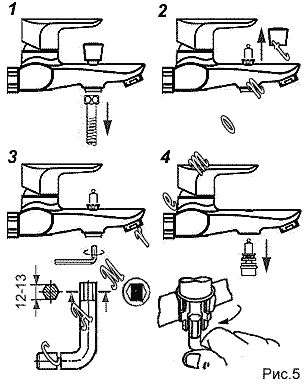
Note: *— A hexagonal metal rod with a distance between opposite faces of 12 ... 13 mm is carefully inserted into the adapter hole (Fig. 6, pos. 29). Hexagonal square (Fig. 5) is held and the adapter is unscrewed (Fig. 6, pos. 24)
The valve body (Fig. 6 pos. 23) without a button (Fig. 6 pos. 16) is pushed out of the base of the mixer body (Fig. 5 pos. 4)
Hexagonal square (Fig. 5) hold and turn away adapter (fig.6 pos.24). Valve body (fig.6 pos.23) without buttons (Fig.6 pos.16) are pushed out of the base mixer body (fig.5 pos.4).
Such L-shaped hex keys are usually used when working with power tools.
The pushbutton switch during repair is disassembled in the following sequence:
- take off first flexible hose (fig.4 pos.11) with union nut (fig.4 pos.6) under the button;
- then remove the decorative button cap (Fig. 4 pos. 16), prying it with a screwdriver blade, and unscrew screw (fig.4 pos.17).
- filmed button (fig.4 pos.15);
- then extract stock (fig.4 pos.19) together with valve (fig.4 pos.20), if the stem is open or the whole button body (fig.6 pos.23) if the button is with a closed stem. Moreover, a button with a closed stem is more durable because the stem spring is closed from contact with water;
- worn out valve rings (Fig. 6 pos. 20, pos. 25 and pos. 26) in the buttons are replaced with new ones;
- a closed button (if it is not disassembled) is replaced with a similar one completely.
Options push-button shower-spout switches for wall-mounted single-lever mixers are shown in Fig.6.
Options for shower-spout pushbuttons for wall-mounted single-lever mixers

16- cap with lid or button; 17- screw; 18- rod spring; 19 - switch rod; 20- stem valve; 21- gland bushing; 22 - stuffing box seal; 23- switch housing; 24- pushbutton switch adapter; 25- sealing rubber ring of the switch body; 26- sealing rubber ring of the adapter; 27- rubber rings of the valve; 28- plastic spout stabilizer; 29- hole adapter for spout.
Before assembling the switch, inspect the sealing surfaces on the open stem button, clean and flush them. spring (fig.6 pos.18) coat with grease.
Advantages and disadvantages
For the convenience of readers, we summarize them in a general table.
| A type | pros | Minuses |
| Suberic | Exceptional fault tolerance: in such a simple design, there is simply nothing to break. | Great switching force; with uneven wear of rubbing surfaces - flow along the rod. |
| Button | Minimum actuation force; compactness of the button protruding beyond the mixer body. | Low resource due to liming of valve rubber. For models with a metal valve, it does not hold water well due to a small pressing force. |
| With barrel and eccentric | Rapid wear of the guides in the mixer body or the keg itself; liming of gaskets. | |
| ball | Almost unlimited resource; the faucet - box for switching the shower always perfectly holds water, requiring minimal effort to switch. | Sensitive to large suspensions. Attempting to close a switch jammed with sand or scale will break the ceramic plates or their plastic retainers. |
Problems and Solutions
Now let's take a closer look at the typical breakdowns of each mechanism and how they are fixed by hand in domestic conditions.
Suberic
There are two typical problems, as we remember:
-
High switching force
. The reason is most often a tightened union nut that fixes the plug in. It is enough just to loosen it slightly; in addition, a layer of silicone plumbing grease can be applied to the outer surface of the cork removed from the body.

-
stem leak
. We have already mentioned the reason: this is uneven wear of rubbing surfaces. Again, a layer of silicone grease will help to correct the situation: it will not only reduce the effort required to turn the lever, but also fill in all the microscopic grooves and scratches between the metal parts.
Button
The push button shower switch also has a few typical problems.
-
The valve does not hold water
. As a rule, the reason is excessively hard water: lime deposits eventually cause the valve rubber to lose elasticity, form uneven growths on it and the seat. For a short time, diligent cleaning of the valve itself and the seat with Whiteness, Domestos or any other decalcifying agent will help; if the rubber has become frankly stiff, the valve with the stem changes completely. - Leak on stock.
How to repair the push button shower switch in the faucet in this case depends on the type of stem seal:
The rubber ring will have to be replaced. A new seal is easy to find as part of a gasket set at any plumbing store.

It is enough to stuff the gland packing again by tightening the gland with moderate force.
-
The button spontaneously returns to its original position with a small pressure of water.
The problem is related to an excessively tight return spring. It is enough to bite off one or two turns of it - and everything will return to normal.
-
The button does not return to its original position when the water is turned off
. The reason is that the stem seal is too tight. It is enough to apply a little silicone grease under the rubber ring; in the design with gland packing, loosen the gland nut.
With a keg
- The faucet does not switch to shower when the lever is turned.
The reason may be:
- The protrusion of the eccentric broken off by excessive force. Sign - free rotation of the lever without any visible effect. It is treated only by replacing the eccentric.
- Lost elasticity or stripped lining on the keg. Symptom - normal lever travel with moderate effort; the water is only partially switched. It will help to replace the gasket and, sometimes, the screw fixing it.
- Deterioration of the keg or guides in the mixer body: the keg gets upside down and wedged in an intermediate position. The symptom is limited lever travel. It is treated by replacing the barrel or, more often, by completely replacing the mixer with worn out guides of its body.
- In the event of a stem leak, the instructions are the same as for the pushbutton switch: replace the rubber seal or refill the gland.
ball
As mentioned above, a ceramic switch for a shower or bathtub almost never fails due to normal wear and tear. The cause of the breakdown can only be an attempt to turn the lever when the plates are jammed with scale or sand.
If a breakdown does occur, the switch cartridge changes completely. The price of this product does not exceed 200 rubles; to replace, just remove the switch lever and unscrew the nut under it.
In the photo - the switch cartridge.
Watering can
Since we have touched on the repair of the faucet in the bathroom, it would be logical to mention one more problem - a malfunction of the shower head, in which water comes from only part of the holes in it.
The reason is sand and lime deposits clogging the holes. It is enough to disassemble the watering can and shake out the sand or wash the holes with the same Whiteness or Silit (acid detergent).
The only problem with this simple repair is the disassembly of the watering can in the case when fasteners are not visible within sight.
Two little tricks can help here:
- Often, the mounting screw can be found under the plastic plug in the middle of the grid.
- Sometimes the watering can can be disassembled by fixing the shower switch with a hand - the shower is on it and turning the grid counterclockwise.
Types of check valves and their common problems
Over the past decades, the design of switches has undergone significant changes. Many of the Soviet types of switches have been replaced with more modern counterparts. Let's take a closer look at new and outdated models in order to understand what you have to deal with. Let's start with the outdated types of shower switches - spool and cork. They have a lever that rotates 90 and 120 degrees. The spool switch is practically not found on the market today, however, if you have an old Soviet-style mixer installed, most likely you are dealing with this particular design. A spool is installed inside the switch, which consists of a barrel and an eccentric. The mechanism is actuated by rotating a rod with a protrusion displaced from the center. The stem controls the movement of the keg up or down. The external feature of this type of switch is the presence of a plastic or metal handle in the form of a flag. Frequent problems of the spool system are breakage of the eccentric lug, failure of the keg, sensitivity to liming, as a result of rotting of the bolts and destruction of the gaskets.
The plug switch is an improved model of the spool switch. A distinctive feature of the cork system is the presence of a slotted brass plug and a switch handle 7–10 cm long inside. This type of switch ceased mass production in the 90s of the last century. However, there are those who still use the mixer with this type of switch. Common reasons that owners of a cork switch can expect are an overtightened nut that disrupts the smooth rotation of the handle, flow along the stem due to partial wear of the cork.
Modern bath-shower switches are push-button/exhaust, ball and cartridge types. The pushbutton switch is externally an exhaust plug with a spring-loaded rod that actuates the shut-off valve. When moving down, it shuts off the water to the spout (gander), switches it to the shower. When the rubber valve wears out, the operation of the locking system is disrupted, water flows simultaneously from the spout and shower head. The wear of the fittings of the exhaust switch also leads to spontaneous return of the button after pressing at a minimum water pressure. In such a situation, we advise you to carefully bite out a couple of turns of the spring with tools and the system will again work properly.
It is easy to recognize the ball switch by the presence of a brass ball inside with perpendicular holes, which is clamped between two plates, and the free rotation of the handle by 360 degrees. When the switch is turned, the ball takes a certain position. It blocks one of the holes, and through the second - water enters the spout or shower. The intermediate position of the lever completely blocks the access of water. Such a system is considered durable. The only thing she is afraid of is the ingress of particles of sand, lime. As a result of sticking, deposits and rust form on the surface, which prevent smooth switching, the lever begins to jam. If nothing is done, the system completely breaks down and fails. Therefore, we advise you to clean the internal fittings of the ball switch from limestone deposits at least once every six months.
The ceramic cartridge is a wear-resistant shut-off valve found in most modern faucets. But like the ball type, it is sensitive to sand particles, scale. Therefore, we recommend installing a coarse water filter in advance. If the switch knob starts to jam, do not make sudden movements. Disassemble and clean the system. Otherwise, you will break one of the ceramic plates or the plastic retainer, the cartridge will have to be completely replaced.
Possible malfunctions
If water flows synchronously in the two positions “shower” and “spout”, then the reason is that the spool gaskets have worn out and no longer perform their functions.
It is necessary to replace them with new ones:
- shut off the water supply;
- disconnect the hose;
- disconnect the gander;
- unscrew the adapter;
- remove the valve handle;
- remove the spool;
- remove old rubber rings;
- new rings should be wetted with plain water;
- put the rings in place;
- assemble the faucet valve.
If water leaked when using the pushbutton switch, the reason may also be the unsuitability of the rubber rings.
To replace rubber rings, you need:
- shut off the water supply;
- unscrew the spout;
- disconnect the adapter using a hex wrench;
- remove the cap;
- get screw
- remove button;
- take out the valve;
- remove the old rings from the valve
- install new rings;
- assemble the switch.
If a push-button switch is installed in the bathroom and its button does not return to its original position when the water is turned off or when the mixer mode is switched, then the breakdown is most likely due to a weak or broken spring.
The process of installing or replacing the spring:
- shut off the water;
- unscrew the spout and hose;
- disconnect the adapter from the switch using an open-end wrench;
- remove the cap of the product;
- remove the screw
- unscrew the button;
- pull out the stem along with the spring;
- replace a broken spring;
- assemble the switch.
If you hear turbulent noises when you turn on the faucet, the reason is the wear of the rubber gasket. You need to unscrew the head and cut off the frayed edge from the gasket.
If water flows continuously from the tap, then the reason may be that the brass valve has become unusable or extraneous small particles have clogged the gap between the valve and the gasket. It is necessary to replace the valve or clean the contamination inside the mixer.
If no water comes out when you open the faucet, the reason may be that the rubber gasket has dried out. First, you can try a simple way - open the faucet and hit it with a wooden object. Otherwise, it is necessary to block the access of water, remove the valve head and slightly tuck or turn the gasket itself over.
If it is not possible to open the valve through its scrolling, then the reason lies in the fact that the thread of the stem has become unusable. It is necessary to replace the stem or wind the wire if the thread is not completely worn out.
Switch
Button
There are the following types of this device:
automatic type
- used in the design of the latest cartridge-type products. This device is located in the area of a self-contained unit or on the outside of the swivel spout. The peculiarity of the element lies in the invariance of its position when the water is blocked. The button implements the regulation option: when it is removed, water will begin to flow out of the watering can.
simple type
- used on cheap models of mixers. However, in appearance, no differences from the automatic type switch are observed. The difference between these devices is manifested in their features of work. To see this, you need to get the button and turn off the water supply. If it remains in an immovable state, the device should be considered simple.
A faucet shower push button switch can upset its owner in the following ways:
- Having ceased to shut off the water in extreme positions;
- Spontaneously switching from a shower to a gander with a weak pressure of water.
The reason for the first malfunction in modern mixers is the wear or destruction of the rubber valve. In this case, it needs to be replaced. Fortunately, in most new plumbing fixtures, the faucet bath/shower switch is designed as a separate assembly that screws directly into its body.
The reason for the second problem is too strong a return spring. She needs to bite off one or two turns with side cutters.
Lever
How to repair the mixer if the lever switch stops working (it is easy to recognize it by moving the handle 90-120 degrees)?
To access the switch you need:
- Remove the plastic plug on the handle;
- Remove the handle;
- Unscrew the nut under it;
- Pull out the rod with the eccentric;
- Remove the gander and nut under the shower hose;
- Take out the barrel with gaskets.
The most common failure that interferes with the operation of the switch is the destruction of one or both gaskets on the keg. They are replaced with new ones.
If the handle moves freely, but the water does not switch, the cause may be a broken protrusion of the eccentric, which sets the keg of gaskets in motion. In this case, the switch changes entirely. The repair kit consists of an eccentric and a barrel.
What does the repair of the shower switch in the mixer look like if the handle is periodically wedged in intermediate positions?
Alas, no way. The reason is the wear of the guides on the mixer body. The device is completely changed.
ball
Alas, about its repair, I can not tell the dear reader absolutely nothing. The fact is that in my memory not a single switch of this type has broken yet. From here, by the way, a rather obvious instruction follows: if you are only going to buy a faucet for the bathroom, you should prefer a model with a ball switch. It is easily recognizable by its full turn handle.
Ball switches are equipped only with mixers with kranbuks - ceramic and (less often) screw.Curiously, the price of these exceptionally reliable appliances is on average lower than that of frequently broken faucets with pushbutton and lever switches.
In the photo - a mixer with a ball switch.
Problems and Solutions
Now let's take a closer look at the typical breakdowns of each mechanism and how they are fixed by hand in domestic conditions.
Suberic
There are two typical problems, as we remember:
-
High switching force
. The reason is most often a tightened union nut that fixes the plug in. It is enough just to loosen it slightly; in addition, a layer of silicone plumbing grease can be applied to the outer surface of the cork removed from the body.

-
stem leak
. We have already mentioned the reason: this is uneven wear of rubbing surfaces. Again, a layer of silicone grease will help to correct the situation: it will not only reduce the effort required to turn the lever, but also fill in all the microscopic grooves and scratches between the metal parts.
Button
The push button shower switch also has a few typical problems.
-
The valve does not hold water
. As a rule, the reason is excessively hard water: lime deposits eventually cause the valve rubber to lose elasticity, form uneven growths on it and the seat. For a short time, diligent cleaning of the valve itself and the seat with Whiteness, Domestos or any other decalcifying agent will help; if the rubber has become frankly stiff, the valve with the stem changes completely. - Leak on stock.
How to repair the push button shower switch in the faucet in this case depends on the type of stem seal:
The rubber ring will have to be replaced. A new seal is easy to find as part of a gasket set at any plumbing store.

It is enough to stuff the gland packing again by tightening the gland with moderate force.
-
The button spontaneously returns to its original position with a small pressure of water.
The problem is related to an excessively tight return spring. It is enough to bite off one or two turns of it - and everything will return to normal.
-
The button does not return to its original position when the water is turned off
. The reason is that the stem seal is too tight. It is enough to apply a little silicone grease under the rubber ring; in the design with gland packing, loosen the gland nut.
With a keg
- The faucet does not switch to shower when the lever is turned.
The reason may be:
- The protrusion of the eccentric broken off by excessive force. Sign - free rotation of the lever without any visible effect. It is treated only by replacing the eccentric.
- Lost elasticity or stripped lining on the keg. Symptom - normal lever travel with moderate effort; the water is only partially switched. It will help to replace the gasket and, sometimes, the screw fixing it.
- Deterioration of the keg or guides in the mixer body: the keg gets upside down and wedged in an intermediate position. The symptom is limited lever travel. It is treated by replacing the barrel or, more often, by completely replacing the mixer with worn out guides of its body.
- In the event of a stem leak, the instructions are the same as for the pushbutton switch: replace the rubber seal or refill the gland.
ball
As mentioned above, a ceramic switch for a shower or bathtub almost never fails due to normal wear and tear. The cause of the breakdown can only be an attempt to turn the lever when the plates are jammed with scale or sand.
If a breakdown does occur, the switch cartridge changes completely. The price of this product does not exceed 200 rubles; to replace, just remove the switch lever and unscrew the nut under it.
In the photo - the switch cartridge.
Watering can
Since we have touched on the repair of the faucet in the bathroom, it would be logical to mention one more problem - a malfunction of the shower head, in which water comes from only part of the holes in it.
The reason is sand and lime deposits clogging the holes. It is enough to disassemble the watering can and shake out the sand or wash the holes with the same Whiteness or Silit (acid detergent).
The only problem with this simple repair is the disassembly of the watering can in the case when fasteners are not visible within sight.
Two little tricks can help here:
- Often, the mounting screw can be found under the plastic plug in the middle of the grid.
- Sometimes the watering can can be disassembled by fixing the shower switch with a hand - the shower is on it and turning the grid counterclockwise.
List of nodes
What can go wrong in a mixer?
Kranbuksa (screw or ceramic). She stops turning off the water. Another malfunction is less commonly observed: the tap opens, but the water does not flow;
- Shower switch. It can be push-button, lever or ball;
- Often, gaskets leak under the spout, as well as between the mixer body and the kosunok (eccentrics);
- The absence or weak pressure of water may mean that the filter on the gander is clogged;
- The reason for the leak of the shower hose is the rupture of its rubber core inside the armor;
- Poor pressure of hot and cold water when supplied to the shower is a consequence of clogging of the nozzles of the watering can.
Conclusion
Of course, in a short article I could not talk about all the possible malfunctions and how to fix them. However, I hope that the solutions I have described will allow the reader to enjoy the flawless performance of plumbing for many years to come. As usual, you will find additional information in the video in this article. I look forward to your comments. Good luck, comrades!
Modern people are so accustomed to the benefits of civilization that such an important piece of plumbing as a faucet is taken for granted. "Acquaintance" with the mixer occurs only when water stops flowing from it, or vice versa, flow during closing. Repairing a faucet and a switch to a shower in a bathroom seems like something transcendental for some. However, there is nothing complicated here. To do this, you need to familiarize yourself with the design of the node in order to diagnose problems.
